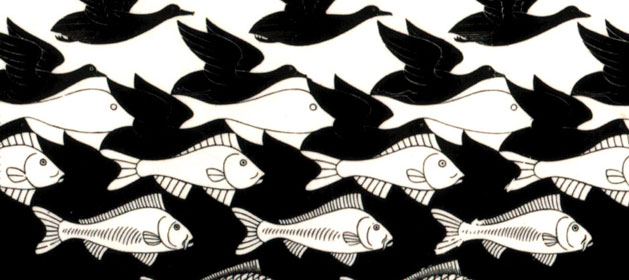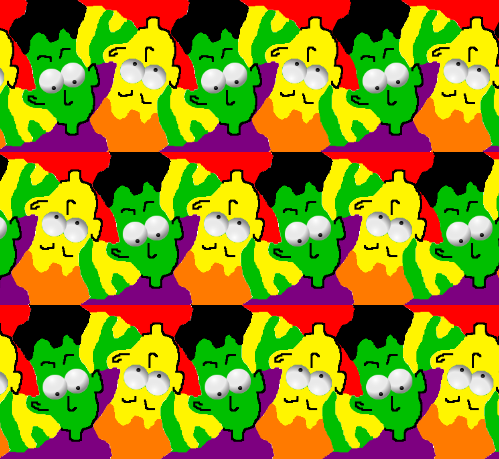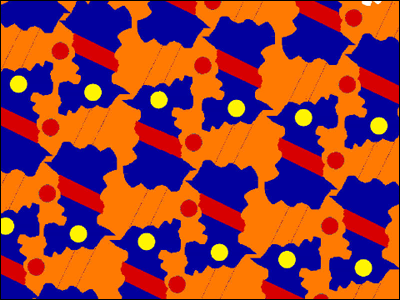
Students will study the mathematical concepts of patterns, planes, symmetry, and translation and learn about the work of M.C. Escher in order to create their own tessellations.
Apps: Wixie®

Many of the concepts you learn in a math classroom can be found in other school subjects… including art. M.C. Escher was an illustrator known for his very precise, scientific, and mathematical drawings. In this activity, you will learn the mathematical concepts of pattern and symmetry and then create your own Escher-like art in the form of tessellations. Your work will be displayed in your school’s own Escher-esque gallery.
The connections between art and math are evident and numerous, yet often overlooked. Exploring tessellations and the art of Escher is a great way to help students make these connections.
As students enter your classroom, ask them to look at the floor or ceiling tiles and use math terms to describe them. You should hear words like patterns, shapes, squares, symmetry, mosaic, and planes.
Share a few examples of tessellations create by Escher. You might consider using Development I, 1937 (rotation), Day and Night, 1938 (reflection), or Sky and Water I, 1938 (translation). Ask your students if they recognize the work of art and can name the artist.
What does the artwork have in common with the floor or ceiling tiles in the classroom?
Work as a class to develop your own definition of tessellation. Listen carefully for words like shape, pattern, repetition, and symmetry.
Let students know that they will learn more about art and symmetry as they create their own tessellations.
As a class, explore the basic attributes of tessellations:
Work together to brainstorm shapes that tessellate. Squares are easy, and, in fact, the word tessellate comes from the Greek word “tesseres,” which means “four.” A simple tessellation is an arrangement of small squares in a checkered or mosaic pattern. Triangles, rectangles, and parallelograms also tessellate.

Draw each shape on the board and invite students to draw lines of symmetry on each shape and explain how symmetry allows the shapes to tessellate. Explore the four types of symmetry in a plane – reflection, translation, rotation, and glide rotation – and how these can be used to create tessellations.
As a class, watch the interviews with Escher on the official M.C. Escher Web site. Once the class has watched the interviews, review his symmetry prints in the picture gallery. Students should look closely at the art and discuss the original shapes Escher used to create the art.
You can create tessellations on paper, but it can be time consuming and tedious. The computer makes this exercise so much easier!
It is easy to create reflection, rotation, and translation tessellations in tools like Pixie or Wixie.
Have students print their tessellations and turn your room into an Escher-esque gallery. Invite parents, school leaders, and other classes to come in and view the images in your gallery. Have your students act as docents to explain more about tessellations and the works of Escher. You might even want to have them create printed handouts to share with gallery visitors.
You could also post the student work to your Web site. In this case, a student-created introduction to tessellations and M.C. Escher would be even more useful.

As you activate prior knowledge by describing floor and ceiling tiles and examining the images created by Escher, you will have an idea of how well your students understand symmetry and how shapes can be tessellated. As students build their tessellations, you can evaluate their mathematical understanding of symmetry as well as visual skill using layers and colors. You may want to put the final images into your students’ portfolios and have them record their reflections on the process.
Official M.C. Escher Web site: http://www.mcescher.com/
Mathematical Art of M.C. Escher: http://www.mathacademy.com/pr/minitext/escher/
Tessellations: http://www.tessellations.org/
National Gallery of Art Tour http://www.nga.gov/collection/gallery/ggescher/ggescher-main1.html
Schattschneider, Doris. M.C. Escher: Visions of Symmetry ISBN: 0810943085
Seymour, Dale. Introduction to Tessellations ISBN: 0866514619
Geometry
Reason with Shapes and their attributes
8.G.A.4. Understand that a two-dimensional figure is similar to another if the second can be obtained from the first by a sequence of rotations, reflections, translations, and dilations; given two similar two-dimensional figures, describe a sequence that exhibits the similarity between them.
In grades K-12 all students should:
understand the visual arts in relation to history and cultures.
make connections between visual arts and other disciplines.
6. Creative Communicator
Students communicate clearly and express themselves creatively for a variety of purposes using the platforms, tools, styles, formats and digital media appropriate to their goals. Students:
a. choose the appropriate platforms and tools for meeting the desired objectives of their creation or communication.
b. create original works or responsibly repurpose or remix digital resources into new creations.
c. communicate complex ideas clearly and effectively by creating or using a variety of digital objects such as visualizations, models or simulations.
d. publish or present content that customizes the message and medium for their intended audiences.

Follow us on Instagram for daily inspiration

Create a thought web, cluster, flowchart, or other graphic organizer for a lesson
8 first projects to get students using technology
Creative, digital book reviews
Fun and powerful ideas with animated characters

Wixie
Share your ideas, imagination, and understanding through writing, art, voice, and video.

Rubric Maker
Create custom rubrics for your classroom.

Pics4Learning
A curated, copyright-friendly image library that is safe and free for education.

Wriddle
Write, record, and illustrate a sentence.

Get creative classroom ideas delivered straight to your inbox once a month.
Topics